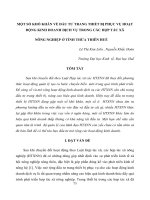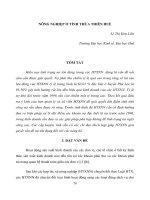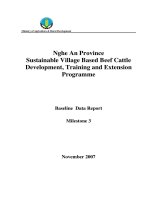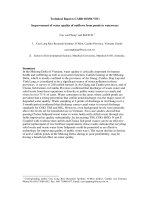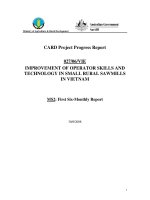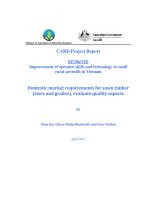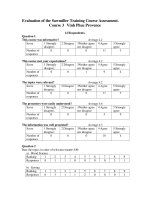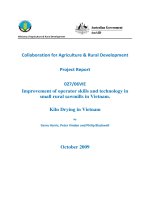Nghiên cứu khoa học nông nghiệp " COMPARISON OF THE PATHOTYPES AND VIROTYPES OF PATHOGENIC ESCHERICHIA COLI IN DISEASED PIGS IN VIETNAM AND QUEBEC, CANADA " doc
Bạn đang xem bản rút gọn của tài liệu. Xem và tải ngay bản đầy đủ của tài liệu tại đây (62.87 KB, 3 trang )
COMPARISON OF THE PATHOTYPES AND VIROTYPES OF PATHOGENIC ESCHERICHIA COLI
IN DISEASED PIGS IN VIETNAM AND QUEBEC, CANADA
Thuy, N. Do
1
; Darren J. Trott
2
, Éric Nadeau
3
, Clarisse Desautels
4
, and John M. Fairbrother
4
1
National Institute of Veterinary Research, Viet Nam,
2
The University of Adelaide, SA 5055, Australia
3
Prevtec microbia Inc, Saint-Hyacinthe, Quebec, Canada
4
Reference laboratory for E. coli, Faculté de médecine vétérinaire, Université de Montréal, Canada
.
Introduction
Diseases caused by E. coli have been a recognised problem for as long as pigs have been raised. Different categories of E.
coli have been associated with diarrhoeal disease in animals worldwide with enterotoxigenic E. coli (ETEC) and Shiga
toxin-producing E. coli (STEC) being the most common (DebRoy & Maddox, 2001). The objective of this study was to
compare the distribution of virotypes of pathogenic E. coli isolates from diseased pigs in two geographically distinct
countries, Vietnam and Canada.
Materials and Methods
E. coli isolates obtained from diseased pigs (diarrhea, sudden death or edema disease) in 2007 and submitted to the NIVR in
Vietnam or the FMV in Québec, Canada, were initially tested by PCR for the presence of defining genes of ETEC and
STEC pathotypes. They were then virotyped by colony hybridisation (Ngeleka et al., 2002) for detection of the presence of
20 virulence genes most commonly found in animal pathogenic E. coli.
Results
Table 1:
Virotypes of ETEC-STEC isolates
ETEC-STEC pathotype
Number of isolates
Virotype
Vietnam Québec
ETEC-STEC F18
LT:STa:Stx2:Paa:F18 13 0
STa:STb:Stx2:AIDA:F18 4 0
STa:STb:Stx2:Paa:AIDA:F18 3 0
Other 6 0
Total ETEC-STEC F18 26 0
Other 1 4
Table 2:
Virotypes of STEC isolates
STEC pathotype
Number of isolates
Virotype
Vietnam Québec
STEC F18
Stx2:Paa:AIDA:F18 4 2
Stx2:AIDA:F18 4 1
Stx2:EAST1:AIDA:F18 0 8
Other 2 3
Total STEC F18
10 14
Other 4 9
Table 3: Virotype of ETEC isolates
ETEC pathotype
Number of strains
Virotype
Vietnam Québec
ETEC F4
LT:STa:STb:EAST1:Paa:F4 12 5
STa:STb:EAST1:F4 8 0
LT:STb:EAST1:F4 3 14
LT:STb:EAST1:Paa:F4 2 19
Other 2 8
Total ETEC F4 27 46
ETEC F18
STa:STb:AIDA:F18 3 0
LT:STa:STb:EAST1: F18 0 2
Other 3 1
Total ETEC F18 6 3
ETEC F5-F41
STa:Paa:F5 17 9
Other 0 4
Total ETEC F5-F41 17 13
Other
LT:STa:STb:EAST1: Paa 7 0
Other 13 63
Total 20 63
Discussion
Our results demonstrate that the most important pathotypes associated with diarrhea, ETEC F4, ETEC F18, and ETEC F5,
and edema disease, STEC F18, are present in both countries. On the other hand, typing using additional virulence genes
permitted further discrimination of the isolates, which demonstrated that distinct virotypes predominate in each country.
Interestingly, the ETEC-STEC F18 pathotype, was very frequently observed in Vietnam, but was not identified in isolates
from Quebec. Thus, virotyping is a valuable tool for monitoring the geographical distribution of virotypes worldwide and
the emergence of new pathogenic variants. We are presently setting up a database for the global surveillance of animal
pathogenic E. coli.
References
DebRoy, C. & Maddox, C. W. (2001). Animal Health Research Reviews 2, 129-140.
Ngeleka M, Brereton L, Brown G, Fairbrother JM. 2002. Avian Dis 46:143-152.
COMPARISON OF THE ANTIMICROBIAL RESISTANCE OF PATHOGENIC ESCHERICHIA COLI
IN DISEASED PIGS IN VIETNAM AND QUEBEC, CANADA
Thuy, N. Do
1
; Darren J. Trott
2
, Éric Nadeau
3
, Clarisse Desautels
4
, and John M. Fairbrother
4
1
National Institute of Veterinary Research, Viet Nam,
2
The University of Adelaide, SA 5055, Australia
3
Prevtec microbia Inc, Saint-Hyacinthe, Quebec, Canada
4
Reference laboratory for E. coli, Faculté de médecine vétérinaire, Université de Montréal, Canada
.
Introduction
Escherichia coli is an important cause of a wide range of
diseases in production animals and humans worldwide,
including pigs. In certain cases, animals are a reservoir of
infection for humans, either by direct contact,
contamination of the environment, or via contaminated
food. The objective of this study was to compare the
distribution of antimicrobial resistance of pathogenic E.
coli isolates from diseased pigs in two geographically
distinct countries, Vietnam and Canada, with differing
antimicrobial use.
Materials and Methods
E. coli isolates obtained from diseased pigs (diarrhea,
sudden death or edema disease) in 2007 and submitted to
the NIVR in Vietnam or the FMV in Québec, Canada,
were initially tested by PCR for the presence of defining
genes of ETEC and STEC pathotypes. They were then
virotyped by colony hybridisation (Ngeleka et al., 2002)
for detection of the presence of 20 virulence genes most
commonly found in animal pathogenic E. coli. The
isolates were examined by the disk diffusion test to
identify antimicrobial resistance.
Results
Table 1:
Prevalence of antimicrobial resistance in
pathogenic E. coli isolates
% of resistance
Antimicrobial
Canada (n=124) Vietnam (n=50)
Ceftiofur 5 0
Ampicillin 67 42
Apramycin 12 0
Spectinomycin 46 4
Gentamycin 7 14
Enrofloxacin 0 20
Florfenicol 12 32
Trim-Sulfa 48 82
Neomycin 23 18
Tetracycline 95 92
Figure 1:
Prevalence of antimicrobial resistance in
porcine pathogenic E. coli isolates from Vietnam and
Canada
Discussion
The antimicrobial resistance profiles generated can be
considered to be representative of each geographical
region. Some interesting similarities and differences were
demonstrated between the two data sets. Overall, very
high rates of resistance were found to tetracycline in
isolates from both countries, Canada and Vietnam (95
and 92%, respectively). Interestingly, all the Vietnamese
isolates were sensitive to ceftiofur and apramycin,
whereas no resistance was recorded for enrofloxacin with
the Canadian isolates. The similarities and differences in
antimicrobial resistance between the two countries could
be attributed to variation in veterinary antimicrobial
regulation and usage between Canada and Vietnam. This
was definitely the case for tetracycline, ampicillin, and
sulfa drug use in both countries, and ceftiofur and
apramycin use in Canada, and enrofloxacin use in
Vietnam. Frequent usage of agents in the past, such as
chloramphenicol in Vietnam and nitrofurantoin in
Canada also was associated with resistance. Other factors
may include the distribution of serotypes and pathotypes
between the two countries, and differences in farrowing
shed management.
References
Ngeleka M, Brereton L, Brown G, Fairbrother JM. 2002.
Avian Dis 46:143-152.
0
10
20
30
40
50
60
70
80
90
100
Ceftiofu
r
Ampicil
li
n
A
pr
amycin
Gentamycin
Neomycin
Enrofloxacin
Florfenicol
S
p
ectinomycin
Tr
i
m‐Sulfa
Tetracy cline
C anada
Vietnam

